Molecular phylogenetics analysis and integrated taxonomy
- Researches in Tsukuba Botanical Garden
- Understanding biodiversity
- Research on the evolutionary processes and Endangered plants
- Molecular phylogenetics analysis and integrated taxonomy
Exploring biodiversity is important not only to increase our understanding of the process of biological evolution, but also to learn about biological resources and environments, which are important for survival of the human race. Living organisms differ from one another, and groups of similar organisms form populations and species. Based on their affinities and phylogenetic relationships, species are classified by taxonomic rank (e.g., “genus”, “family” etc.). Species, one of the basic units of taxonomy, evolved under the constraint of phylogenetic relationships. Therefore, an integrated approach toward understanding phylogenetic relationships and characteristic features of species is essential to increase our understanding of biodiversity. The Tsukuba Botanical Garden is conducting studies on biodiversity that consider both phylogenetic relationships and characteristic features of plant species. An intermediate report on the results of research activities conducted by the National Museum of Nature and Science, as part of the comprehensive research program “Integrated Research on the Molecular Phylogeny and Classification of all Living Organisms”, is provided below.
Research 1: Evolution of Osmunda japonica
The subgenus Osmunda comprises four species. Osmunda japonica is found in East Asia. Osmunda lancea, a endemic species to Japan, grows on rocks along the banks of a river, and O. regalis is distributed worldwide except East Asia. Osmunda hybrida is a tetraploid hybrid between O. regalis and O. japonica and distributed in Laos and Myanmar. Our research was conducted to study the evolutionary process of O. japonica and O. lancea. Analysis of maternally inherited chloroplast DNA revealed that O. japonica is very closely related to O. lancea. It was also found that the American O. regalis is more closely related to O. japonica than to the other populations of O. regalis in the Old World (Europe, Africa, and Asia). On the other hand, nuclear DNA analysis shows that O. regalis from all over the world are close, and that the species is phylogenetically apart from O. japonica. We assume that an introgression likely occurred between the American O. regalis and O. japonica in chloroplast DNA after divergence of the species. The causes of incongruence between molecular phylogeny and morphological classification must be investigated for understanding the evolution of subgenus Osmunda.
Osmunda lancea is a rheophyte, which is adapted to the ecologically specialized river-bank subject to periodical flooding with swift turbulence after heavy rains. Rhododendron indicum, which is popular as ornamental plants in Japan, is also a rheophyte. All of the approximately 1,000 species of rheophytes that have been discovered to date have streamlined leaves or leaf blades. This is an adaptation that helps rheophytic plants withstand the increase in water pressure when they get submerged due to rapid flooding of the river caused by heavy rains. Although O. lancea is suggested to have evolved from O. japonica, many details about the species still remain unknown, e.g., where, when, how many times, and from which groups O. lancea was evolved, and how adaptive characters such as narrow leaves (leaf blades) evolved during the evolution. These researches are important to enhance understanding of rheophytic plants and of adaptive evolution in organisms as well.
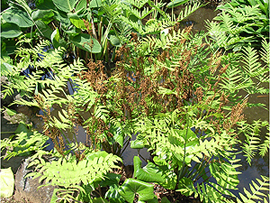
Osmunda japonica
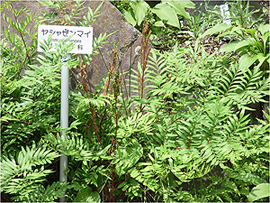
O. lancea
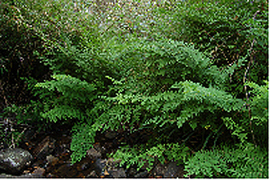
O. regalis
Research 2: Classification of the Genus Liparis
Liparis is cosmopolitan genus and includes 320 species worldwide. Approximately 15 species are distributed in Japan. Liparis kumokiri is frequently seen in wild in Japan. Several Liparis species, such as L. makinoana, have fascinated researchers and other flower enthusiasts. There are several taxonomic problems and some unknown species exist in Japan. DNA analyses and morphological comparisons of several Liparis species led to the discovery of two new species. One new species, L. purpureovittata, closely resembles L. kumokiri but the flowers of L. purpureovittata are somewhat sparse in the flower stalk, the labellum abruptly dilated above the base (gradually dilated in L, kumokiri) and the center of the labellum base has a purple spot (uniformly pale green in L. kumokiri). Molecular analyses revealed that L. purpureovittata are genetically differed from L. kumokiri. The other new species, L. koreojaponica, is distributed in northern part of Japan and South Korea. It closely resembles L. fujisanensis, but the flowers of L. koreojaponica are larger and are more sparsely attached in the stalk. The species is genetically close but distinct from L. fujisanensis in several chloroplast markers examined. Phylogenetic analysis of several species of Liparis using multiple genes revealed that L. kumokiri, L. purpureovittata, L. fujisanensis, and L. koreojaponica are closely related and they are apart from L. makinoana and L. japonica. The research is unraveling the systematics and classification of the Liparis, as well as providing information on diagnostic characters that is important for classification.
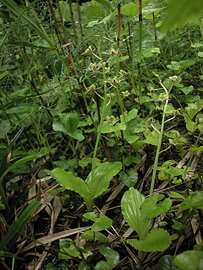
Liparis purpureovittata
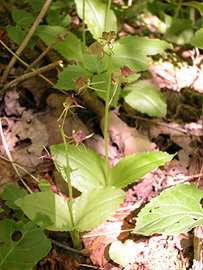
Liparis koreojaponica
Creation of a system to manage information on biodiversity
Taxonomy classifies biodiversity based on a classification system. As information on biodiversity will increase in the future, it is important to create a highly versatile and efficient system that facilitates usage of this information. The system must integrate various information; phylogenetic trees; classification systems; taxonomic keys; characteristics; usages; descriptions and photographs of key characters for speciation; knowledge and finding sources related to evolution. The National Museum of Nature and Science will play an important role in creating and maintaining an integrated bioinformatics system that utilizes an electronic database for biodiversity-related information.
